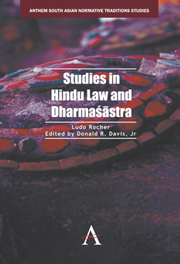Book contents
- Frontmatter
- Contents
- Foreword by Richard W. Lariviere
- Preface
- Abbreviations
- Note on the Edition
- Introduction
- PART ONE THE NATURE OF HINDU LAW
- PART TWO GENERAL TOPICS OF HINDU LAW
- PART THREE HINDU LEGAL PROCEDURE
- PART FOUR TECHNICAL STUDIES OF HINDU LAW
- PART FIVE ANGLO-HINDU AND CUSTOMARY LAW
- Indian Response to Anglo-Hindu Law
- Can a Murderer Inherit his Victim's Estate? British Responses to Troublesome Questions in Hindu Law
- Reinterpreting Texts: When Revealed Sanskrit Texts Become Modern Law Books
- Father Bouchet's Letter on the Administration of Hindu Law
- Jacob Mossel's Treatise on the Customary Laws of the Veḷḷāla Cheṭṭiyārs
- Bibliography
- Index
Can a Murderer Inherit his Victim's Estate? British Responses to Troublesome Questions in Hindu Law
from PART FIVE - ANGLO-HINDU AND CUSTOMARY LAW
Published online by Cambridge University Press: 05 February 2013
- Frontmatter
- Contents
- Foreword by Richard W. Lariviere
- Preface
- Abbreviations
- Note on the Edition
- Introduction
- PART ONE THE NATURE OF HINDU LAW
- PART TWO GENERAL TOPICS OF HINDU LAW
- PART THREE HINDU LEGAL PROCEDURE
- PART FOUR TECHNICAL STUDIES OF HINDU LAW
- PART FIVE ANGLO-HINDU AND CUSTOMARY LAW
- Indian Response to Anglo-Hindu Law
- Can a Murderer Inherit his Victim's Estate? British Responses to Troublesome Questions in Hindu Law
- Reinterpreting Texts: When Revealed Sanskrit Texts Become Modern Law Books
- Father Bouchet's Letter on the Administration of Hindu Law
- Jacob Mossel's Treatise on the Customary Laws of the Veḷḷāla Cheṭṭiyārs
- Bibliography
- Index
Summary
Some time in 1914 Chanbasava, a widow from Dharwar District —at the Southern end of what was then the Bombay Presidency— had a quarrel with her late husband Ramanna's brother's son, Hanmappa. Hanmappa filed a suit to claim that he was Chanbasava's —and her late husband's— adopted son. He failed to establish his claim in court, and, within two days, “revenged himself for his failure” by murdering Chanbasava. Hanmappa was convicted of murder and, under Section 302 of the Indian Penal Code, sentenced to transportation for life.
The decision of the criminal court did not, however, solve the civil issue. Hanmappa, the murderer, was also heir to Chanbasava's estate, and he had two sisters, Kenchava and Gangava, who would inherit if Hanmappa was not disqualified as heir to Chanbasava. At the same time there was another nephew, Ramanna's sister's son, Girimallappa, who would inherit, and he alone, if Hanmappa was disqualified. Girimallappa went to the civil courts to establish his claim.
The Anglo-Indian civil courts were faced with the problem: can a murderer inherit his victim's estate? or, even if he loses all beneficial rights personally, is he, for the sake of the inheritance, existent or non-existent? The case was decided by the First Class Subordinate Judge at Dharwar, H.V. Chinmulgund. It was appealed to the High Court in Bombay, before Chief Justice Sir Norman Macleod and Mr. Justice Charles Fawcett. The decision of the Bombay High Court was appealed again, before the Judicial Committee of the Privy Council, at Westminster in London.
- Type
- Chapter
- Information
- Studies in Hindu Law and Dharmasastra , pp. 643 - 660Publisher: Anthem PressPrint publication year: 2012



